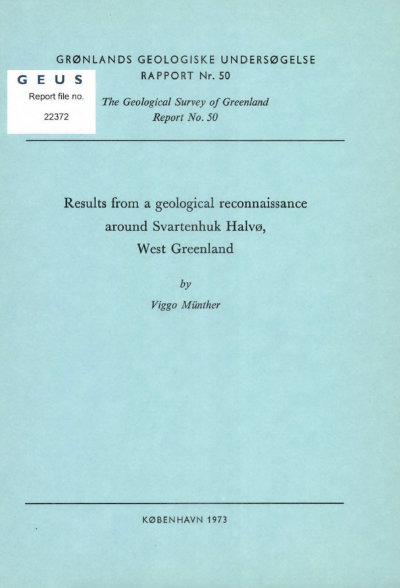Results from a geological reconnaissance around Svartenhuk Halvø, West Greenland
DOI:
https://doi.org/10.34194/rapggu.v50.7318Abstract
Svartenhuk Halvø is built up primarily of Tertiary basalts; these overlie Cretaceous and early Tertiary sediments, and overlap onto the Precambrian basement. The basalt series can be divided into a lower and an upper series; although displaced by faults, the boundary between these series can be followed across the peninsula. The thickness of the lower basalt series is estimated to be about 2-3 km in the south of the peninsula and barely 1 km in the north; the sub-aquatic basalt breccia is included in these thicknesses. FauIts causing repetitions of the lava succession have resulted in the series being preserved over a rather large area. The general dip of the lavas is 3-4 dregrees towards SW in the east and 8-10 degrees, also towards SW, in the west. Locally dips between 10 and 20 degrees or even steeper are seen; these are the resulf of drag along fault zones in Arfertuarssuk fjord and Kugssineq valley, and between Svartenhuk Halvø and Ubekendt Ejland. The youngest fault has a displacement of 500 m or more and has downthrown the basement area to the north-east in relation to the sediment-basalt breccia-basalt series to the south-west. The upper basalt series has by far the greater lateral extent and covers the gneiss and metasediment area to the north and north-east at least as far as the Inland lee. The dip of the flows in this part of the basalt series is considerably lower than in much of the lower basalt series, but faults repeating the succession are also frequently encountered within the upper basalts. The tectonic movements evidence a strong E-W (or NE-SW) tension, never a compression; the weak anticlinal and synclinal structures which are seen are interpreted as resulfing from differential sagging. The lower basalt series is thought to have arisen from fissure eruptions, with the main area of eruption in the east. The lavas are very rich in olivine (i. e. are pieritic). The upper basalt series probably arose from central eruptions and smaller fissure eruptions, and the area of eruption is thought to have shifted to the west. The upper lavas become poorer in olivine; andesitic lavas represent perhaps a closing phase, more local in its distribution and perhaps resulting from magmatic assimilation of pre-basaltic sediments. "Iron basalt" and intrabasaltic breccia have not been noted on Svartenhuk Halvø.
Downloads
Published
Issue
Section
License
This article is distributed under a CC-BY 4.0 licence, permitting free redistribution and reproduction for any purpose, even commercial, provided proper citation of the original work. Author(s) retain copyright over the article contents.


